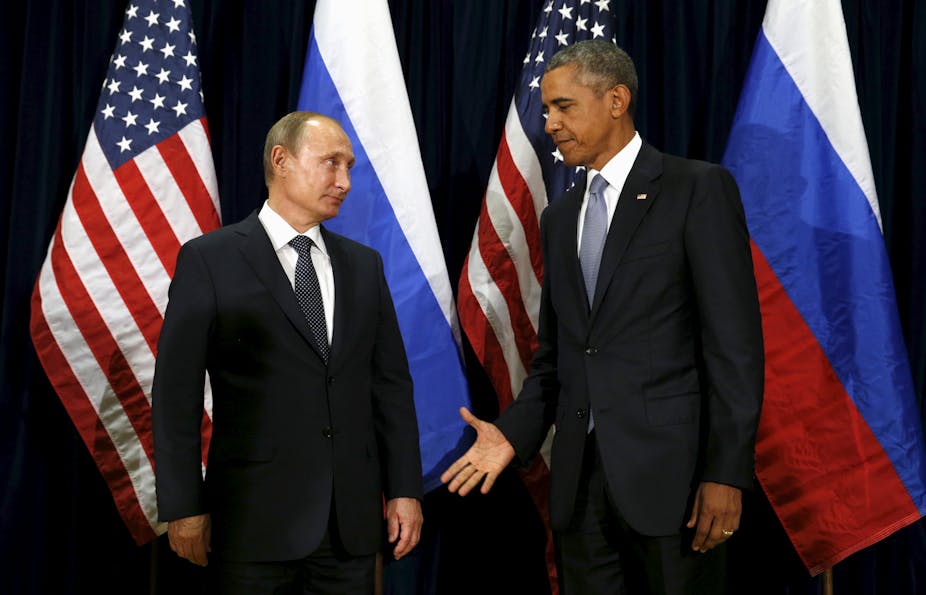Russia’s nascent Syria campaign has certainly gotten off to a rocky start: international scepticism of its aims, provocative forays into Turkish airspace, missiles apparently crashing in Iran.
But with the Pentagon abandoning a key programme to train the Syrian rebels it accuses Moscow of attacking, it’s clear that the game is changing fast on both sides. In a few short days, Moscow has already forced the US’s hand – and it could yet profoundly change the two countries’ relationship.
It wasn’t supposed to be this way. The Obama administration initially tried to “reset” relations with Russia, and for a brief period, NATO resumed dialogue with Russia through the NATO-Russia Council. Russia even contributed to a 2011 NATO exercise, Bold Monarch.
Then came the annexation of Crimea, and as of April 1 2014, all practical civilian and military co-operation between NATO and Russia has been suspended indefinitely.
Suspicious minds
Russia’s actions in Crimea, later in Eastern Ukraine, and now in Syria are all examples of Russia’s Gerasimov Doctrine, more commonly known as hybrid warfare.
Russia’s articulated perception of the West - and especially the US - is one where opportunities to overthrow legitimate governments that are not agreeable to US grand strategy are pursued through the CIA. From Russia’s point of view, this includes not only the “colour revolutions” in Europe and Central Asia, but also the Arab Spring.
Whether this view of the West is sincerely believed behind the Kremlin’s closed doors is debatable. Nonetheless, the Gerasimov Doctrine is Russia’s way of denying what it sees as the West’s constant expansion into its traditional security perimeter and for forcing regime change with Russia’s traditional allies abroad.
NATO is bolstering its defensive posture, but the alliance was created primarily to deter full-scale conventional attacks, and it just isn’t designed to deter this type of hybrid warfare. On top of that, it’s also struggling to react to a Russia that is apparently violating the airspace of Turkey (a NATO member) and pouring “gasoline in the fire of Syrian civil war”.
NATO and the US’s attention is now squarely on Russia’s recent actions in Syria. Russia has deployed heavy weaponry there to bolster the Assad regime, which has looked considerably weaker in recent months. And less than a week after the start of its air campaign, Russia has now signalled that “volunteer” ground troops could enter Syria in order to establish more effective coordination with Assad’s forces.
Even if these troops were “volunteers” (which they would not be), the very high-tech equipment they would rely on most certainly would not be privately owned.
Strategic patience
Obama must now make some very difficult decisions. Although Russia purports to be targeting IS positions, the US State Department claims that 90% of the air strikes have not hit IS positions. Many have, in fact, hit the CIA-trained rebels that are fighting the Assad regime. Russia’s entry into the fray has also further crowded the skies over Syria for the coalition forces already operating there.
These developments aren’t just giving the tactical planners of Operation Inherent Resolve day-to-day logistical headaches – they’re serious long-term challenges for the US, and it needs to figure out how to deal with them.
Obama’s dilemma is how to re-establish deterrence without pursuing a tit-for-tat reactionary path that leads to a proxy war with Russia. Striking that balance between acceptable risk and necessary deterrence will not be easy. Even if the US wanted to establish a no-fly zone in north-west Syria – which would’ve been rather easier if it had sole control of Syrian airspace – it would now have to be prepared to defend it against potential Russian violations.

So far, the Obama administration has been applying its doctrine of “strategic patience” and arguing that Russia is setting itself up for a “strategic blunder” in Syria. But pressure is mounting on the administration to react more robustly, and Obama’s team has been gaming out both military and economic responses.
The rationale for strategic patience is clear enough. Syria’s internal combatants have little reason to come to an agreement regardless of what the US and/or Russia do. Equally, while Russia’s actions in Syria may give Moscow more opportunities to disrupt US operations in the Middle East at large, they have also pinned a target on Russia’s back.
Reassure and reassert
The US must do more than simply react to Russia, as that will only leave Putin with the initiative. The only safe way forward is to to simultaneously make the US’s presence felt on Europe’s eastern and southern periphery while at the same time reducing tensions with Russia through some kind of meaningful dialogue. That is not impossible: logistical discussions to avoid accidental engagements in the skies over Syria are not the same as entering into a coalition, and they should not be interpreted as such.
NATO also needs to transform itself into an alliance that can deter both traditional and hybrid threats, and the US has to reassure its allies that it will stand up to Putin’s strategy to undermine American influence in Europe. On October 8, NATO’s defence ministers met collectively to discuss the “troubling escalation of Russian military activities” and pledged to strengthen NATO assurance measures in light of these activities in Syria.
NATO has already been steadily ramping up its military exercises this year. In October and November 2015, the Trident Juncture exercise will be testing the NATO Response Force’s ability to defend its members. During that time, there will be more and more calls for Obama to go eyeball-to-eyeball with Putin in the Middle East.
Obama has no easy options, and this dilemma is probably one of his hardest foreign policy challenges yet. Those demanding he do more are long on bravado and short on solutions. But with no realistic chance of a truly comprehensive negotiated settlement in Syria forthcoming, the best response that the US and Europe can offer Putin is a united one.

